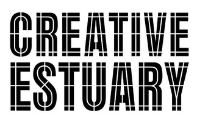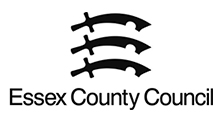NEW COMMISSIONS AND EVENTS ANNOUNCED FOR ESTUARY 2021
Today, we announce new additions to our ambitious programme of arts and discussion presented in the landscape and online during this year’s festival. The newly announced works include commissions by Isaac Cordal, Bryony Gillard, Adam Chodzko, Nadav Kandar and Gabriella Hirst.
An online programme of talks and films, also announced today, includes the inaugural Jan Morris lecture, which will be delivered by Jini Reddy. This lecture is co-commissioned by Estuary 2021 in partnership with Hay Festival in memory of the acclaimed journalist, nature writer and historian, Jan Morris, who died in 2020.
The Opening Weekend programme, An Unknown Earth, will present 22 hours of live broadcast discussion and specially commissioned online artworks exploring the festival themes of climate, rebellion and imperial legacy, including contributions from Fiona Compton, Jeannette Ehlers, Aleema Gray, Michael McMillan, Inua Ellams, Antonio Roberts, Osman Yousefzada, Caryn Franklin and many others.
Audiences can stream a mix of panel discussions, readings, artist presentations and films, and experience artworks commissioned specifically for the online space throughout the three weeks of Estuary 2021, all available for free on our website.
In addition to the online programme, our festival will see over 90 works and events presented in outdoor locations across Essex and Kent, from Shoeburyness to Tilbury, from Gravesend to Margate; including Wat Tyler Country Park, Pitsea and Southend on Sea in Essex; and Northfleet, Chatham Historic Dockyard, and the Isle of Sheppey in Kent. The programme extends from the most easterly points of the Thames as it merges with the North Sea, and into London, with programme at Lesnes Abbey Woods and the nearby brutalist new town of Thamesmead.
Estuary 2021 is a large-scale arts festival curated in response to the Thames Estuary and the lives, landscapes and histories found there. A mix of large scale and intimate visual art, literature, music and film, it celebrates culture, creativity, recovery and renewal. Conceived to be enjoyed outdoors and in a COVID-19 secure way, the festival invites visitors to take an epic walk along the stunning coastline of South Essex and North Kent encountering contemporary artworks and performance within the estuary’s landscape, historic sites and coastal towns.
For this edition, the curators invite artists, writers, local communities and visitors to explore issues around the climate emergency, protest and rebellion and imperial legacy, using the towns, nature reserves, industrial landscapes and spectacular views of the estuary as their starting point.
The estuary coastline as a continuous walk was originally devised by local writer Tom King, in his book Thames Estuary Trail: A Walk around the end of the World which celebrates its 20th anniversary this year. Inspired by King’s book, the festival encourages visitors chart their own route along the trail, discovering artworks that reveal new perspectives on well-known estuary landmarks and some of its lesser known environments.
The newly announced programme adds to a line-up of over 70 contributors including: Mary Mattingly; Marcus Coates; Ackroyd & Harvey; Sadie Hennessey; Jack McNamara; Caroline Bird and Selina Nwulu; Jas Dhillon, James Marriott, Lu Williams and Elsa James; Robert Macfarlane, Zoe Svendsen and Carolyn Downing; Shona Illingworth and Patrick Wright; and Bob and Roberta Smith.
Newly announced programme:
Art in the landscape
· Nadav Kander’s In The End Is The Beginning - Towards The Thames Estuary, is an outdoor installation featuring a triptych from his on-going photographic series, Dark Line - The Thames Estuary, writ large in the landscape it portrays at Shoeburyness. A static representation of the constants of the river placed at one of its most sparsely populated points, Kander’s images consider the passing of time and the rich histories of life, wealth, population and politics connected to the estuary.
· Adam Chodzko’s The Return of the Fleet Spring Heads is a science fiction audio walk around Northfleet, Kent experienced via headphones. Moving along the specified route, the accompanying soundtrack guides the audience’s perceptions, creating new relationships between place, mind and body through its composition of vocal narration and instructions. Moving backwards and forwards through time The Return of the Fleet Spring Heads addresses our collective experience of the pandemic as having shifted our sense of reality, and recalibrates us as we head out into the world.
· Sound Mirrors by artist duo Dot Dash (James Wilkes and Laurence Bradby) is a trail of sound portraits specific to their locations at Southend’s Chalkwell Park, East Beach in Shoeburyness, Wallasea Island, Jaywick Martello Tower, Naze Tower and Harwich Green. Accessed via QR codes hidden as geocaches at each point, the works are based on recorded community voices as they reflect on the personal relationship between locality, sound and emotion. The six geocaches form the Essex leg of the world’s first Art GeoTour, created as part of England’s Creative Coast.
· Feral Practice & Esi Eshun’s Lissener is a new, darkly comic audio work available to download and listen to in the setting of Oare Gunpowder Works. The work responds to the human and nonhuman histories of the place, with its integral watery, vegetal and animal connections to Oare Creek and Oare Marshes. One point of reference is Oare’s explosive past, but diverse stories and temporalities entwine in this watery world, disturbing the expected hierarchies between species and between states of being. If we sensitise ourselves (as vegetal philosopher Michael Marder advises) to the fuzzy edges of our subjectivity in order to meet beings very different to ourselves, might it be in the ‘wilds’ of the imagination that we can better re-align with nonhuman nature?
· Waiting for Climate Change is an outdoor installation by Isaac Cordal sited in the estuary itself on Chalkwell Beach. The Spanish street artist will create a series of 15 characters, visible at low and high tide, readily equipped with mobile phones and diving equipment. Prepared for an emergency, the characters seem to absently look on as the water level rises and the tide comes in. In a challenge to our often-passive relationship with climate change, Cordal hopes to spark discussions around the climate emergency and the risk presented by rising sea levels.
· Bryony Gillard’s Unctuous between fingers is a moving image work that explores the archive of pressed seaweeds and algae held by the Royal Albert Memorial Museum & Art Gallery, collected predominantly by women in the mid-1800s. ‘Seaweeding’, a gendered hobby, was considered a creative pastime of little importance. However, many of the collectors made a significant contribution to marine botany. Made through a process of archival research and collaboration with marine biologists, philosophers, activists and enthusiasts, Unctuous between fingers (originally commissioned by RAMM) will be shown at St Andrew’s waterside church in Gravesend.
· Gabriella Hirst’s An English Garden will be presented at Estuary 2021 as part of her on-going project, How to Make a Bomb. It charts the artist’s attempts to propagate new specimens of the ‘Atom Bomb’ – a near-extinct species of garden rose, first registered in 1953. Since 2019, How to Make a Bomb has been curated by Warren Harper at The Old Waterworks (TOW), close to Foulness Island, where Britain’s first atomic devise was assembled. For the festival ‘Atom Bomb’ roses will be installed in a formal English Garden upriver from Foulness Island at the nature reserve and former MOD site, Gunners Park. An English Garden is intended to recognise the role of Essex in Britain’s nuclear colonial legacy, serving as a reminder that the red rose and the English garden are entangled with a violent past and dangerous present. The project is commissioned through a partnership between The Old Waterworks and Metal, with additional funding from Arts Council England Project Grants.
· A co-commission by Bow Arts and Peabody, Explore Thamesmead is a series of outdoor works from artists Calum F Kerr, Chloe Cooper, Cieron C That, Dom Snow, Marcus Orlandi, Nathalie Coste and Thamesmead Texas working at the area’s historic Brutalist landmark, the Lakeside Centre. The centre has been transformed into a new creative hub for Thamesmead through a partnership between Peabody and Bow Arts with support from the Mayor of London’s Regeneration Fund (LEAP). Estuary 2021 is delighted to partner with RTM.FM, Bow Arts and Peabody Trust at Thamesmead as part of the ongoing work by Creative Estuary and the GLA to create the Thames Estuary Production Corridor - a vision for a landmark corridor along the estuary, powering skills opportunities and new jobs.
· Mirrors for Princes (2019) is a series of traditional pub style mirrors created by Ruth Ewan with sign writer Artisan Artworks that will be hosted by pubs along the Essex coastline of the estuary. The mirrors feature texts channelling the ancient call for social equality and justice and will be accompanied by an edition of slogan beer mats. The English expression ‘mirrors for princes’ refers to an ancient literary genre that outlined the basic principles of moral conduct for rulers. The quotes featured on Mirrors for Princes are derived from writings, texts and speeches by sources including the fourteenth-century radical itinerant priest John Ball (c.1338–1381), eighteenth-century proto-feminist philosopher Mary Wollstonecraft (1759–1797), and the nineteenth-century French anarcho-feminist Louise Michel (1830–1905). John Ball was a key figure in The Peasants’ Revolt of 1381, which was caused, among other things, by a rise in taxes (needed to finance the Hundred Years’ War against France). Sparked by the villagers in the Essex estuarine village of Fobbing, the rebels from across the southeast of England demanded a reduction of taxes, the end of serfdom and the resignation of the king’s chief advisers. Over time, this uprising has become a key moment in British history.
Online programme
· Estuary 2021’s newly announced film programme, The Telling Image is curated by Gareth Evans. It brings together ten short films from eight film-makers that consider the festival themes of climate, protest and rebellion and propose alternative ways of being in the world, arguing for new structures. The films include:
o Anja Kirschner’s Jarmanesque Polly II , part satirical sci-fi, part soap opera and part Brechtian ‘Lehrstueck ‘ portrays the lives of pirates and outcasts surviving in the flooded ruins of future East London
o Waste by emerging filmmaker, Hannah Oliver thinks in images about what waste is and what might be left, when everything is waste
o Sarah Wood & Ali Smith’s found footage essay film The Bravest Boat celebrates the legacy of Margaret Tait’s time in postwar Italy and the origin of her filmic vision
o Morgan Quaintance’s geographically resonant Early Years, a portrait of Jamaican-born artistic polymath Barbara Samuels
o Eelyn E Lee’s Casting Fu Manchu challenges racist casting stereotypes by inviting actors of east and southeast Asian heritage to audition for the role of the Chinese villain Dr Fu Manchu who has only ever been played on screen by white men.
o Gideon Mendel’s lament for a scorched Australian National Park in A Song for the Forest
o Stanley Schtinter’s John on the Void providing the striking insights of acclaimed artist John Akomfrah on a French Polynesian voyage
o Three films by US filmmaker Jem Cohen - This Climate, Bella Ciao and The Militant Ecologist – which bring together music, resistance and extremes of consumption
Talks
· Launching as part of Estuary 2021 and Hay Festival is the inaugural Jan Morris lecture, a co-commission that celebrates the life and work of the acclaimed historian, nature and travel writer, who died last year. Jini Reddy, author of Wanderland: A Search for Magic in the Landscape, will look at non-orthodox perspectives on the landscape, and consider the richness and wisdom they bring. The lecture will be broadcast simultaneously across both festival websites at 1pm on Thursday 27 May.
· An Unknown Earth (a title taken from Conrad’s Heart of Darkness) is the festival’s Opening Weekend of live broadcast discussion and specially commissioned online artworks exploring climate, rebellion and imperial legacy. The event will be brought together by four artists and curators all of whom know the estuary as home: Jas Dhillon, Elsa James, James Marriott, and Lu Williams
· On Saturday 29 May, online community radio station RTM.FM, run by the artist space TACO! (Thamesmead Arts and Culture Office), will respond to the festival themes with a day of live, specially commissioned broadcast works by artists including Anne Hardy, Belinda Zhawi, Benedict Drew, Natasha Bird, Raju Rage, and Time is Away. Once aired the broadcasts will be available on the RTM and Estuary Festival websites.
Previously announced commissions include work by: Mary Mattingly; Marcus Coates; Jas Dhillon; Elsa James; James Marriott; Lu Williams; Jack McNamara; Bernadette Russell and Sophie Austin; Patrick Wright and Shona Illingworth; Laura Daly; Webb-Ellis; Ackroyd & Harvey; Arbonauts; Bob and Roberta Smith; Robert Macfarlane, Zoe Svendsen and Carolyn Downing; Selina Nwulu and Caroline Bird; Cohesion Plus; Sadie Hennessy; Shaun C. Badham; Angela Chan; Harun Morrison; Sonia Hughes, Jo Fong, Lisa Mattocks and Andrew Westle; Helen Prichard, Jara Rocha and Femke Snelting (Underground Division); Andy Freeman and Samantha Penn Out to Dry; Graham Harwood and Matsuko Yokokoji Wasted; Lora Aziz; Maria Amidu; Adam Dant; and Amina Atiq, Season Butler, Alison Moore and Martha Pailing.
More information on the previously announced commissions can be found here.
Image credit: Nadav Kander, Water3 III, part 1,2 and 3, (Shoeburyness towards The Isle Of Grain), 2015

 maybe later
maybe later
.jpg)





